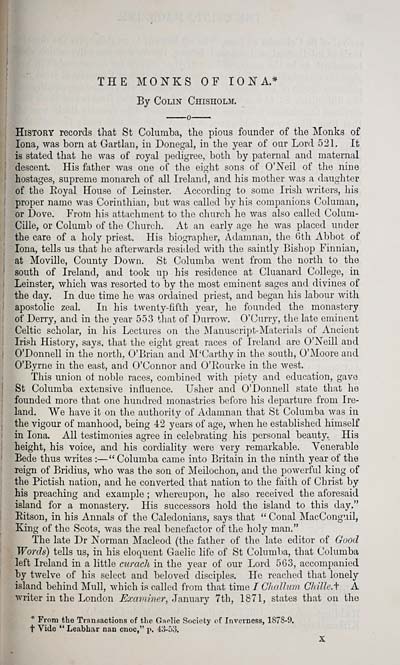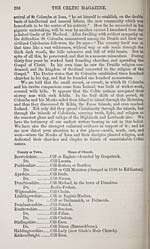Blair Collection > Celtic magazine > Volume 5
(275)
Download files
Complete book:
Individual page:
Thumbnail gallery: Grid view | List view

THE MONKS OF ION A.*
By Colin Chisholm.
History records that St Coluniba, the pious founder of the Monks of
lona, was born at Gartlan, in Donegal, in the year of our Lord 521. It
is stated that he was of royal pedigree, both by paternal and maternal
descent. His father was one of the eight sous of O'Neil of the nine
hostages, supreme monarch of aU Ireland, and his mother was a daughter
of the Eoyal House of Leinster. According to some Irish writers, his
proper name was Corinthian, but was called by his companions Columan,
or Dove. From his attachment to the church he was also called Colum-
Cille, or Columb of the Church. At an early age he was placed under
the care of a holy priest. His biographer, Adamnan, the 6th Abbot of
lona, tells us that Jie afterwards resided with the saintly Bishop Finnian,
at Moville, County Down. St Columba went from the north to the
south of Ireland, and took up his residence at Cluanard College, in
Leinster, which was resorted to by the most eminent sages and divines of
the day. In due time he was ordained priest, and began his labour with
apostolic zeal. In his twenty-fifth year, he founded the monastery
of Derry, and in the year 553 that of Durrow. O'Curry, the late eminent
Celtic scholar, in his Lectures on the ]\Ianuscript-Materials of Ancient
Irish History, says, that the eight great races of Ireland are O'lSTeill and
O'DonneU in the north, O'Brian and M'Carthy in the south, O'Moore and
O'Byrne in the east, and O'Connor and O'Rourke in the west.
This union ot noble races, combined with piety and education, gave
St Columba extensive influence. Usher and O'Donnell state that he
founded more that one hundred monastries before his departure from Ire-
land. We have it on tlie authority of Adamnan that St Columba was in
the vigour of manhood, being 42 years of age, when he established himself
in lona. AU testimonies agree in celebrating his personal beauty. His
height, his voice, and his cordiality were very remarkable. Venerable
Bede thus writes : — " Columba came into Britain in the ninth year of the
reign of Bridius, who was the son of Meilochon, and the powerful king of
the Pictish nation, and he converted that nation to the faith of Christ by
his preaching and example ; whereupon, he also received the aforesaid
island for a monastery. His successors hold the island to this day,"
Eitson, in his Annals of the Caledonians, says that " Conal MacConguil,
King of the Scots, was the real benefactor of the holy man."
The late Dr Norman Macleod (the father of tlie late editor of Good
Words) teUs us, in his eloquent Gaelic life of St Columba, that Columba
left Ireland in a little curacJi in the year of our Lord 563, accompanied
by twelve of his select and beloved disciples. He reached that lonely
island behind Mull, which i.s called from that time / Challum Chille.f A
writer in the London Examiner, January 7th, 1871, states that on the
* From the Transactions of tlie Gaolic Society of Inverness, 1878-9.
t Vide " Leabhar nan cnoc," y>. 43-53,
By Colin Chisholm.
History records that St Coluniba, the pious founder of the Monks of
lona, was born at Gartlan, in Donegal, in the year of our Lord 521. It
is stated that he was of royal pedigree, both by paternal and maternal
descent. His father was one of the eight sous of O'Neil of the nine
hostages, supreme monarch of aU Ireland, and his mother was a daughter
of the Eoyal House of Leinster. According to some Irish writers, his
proper name was Corinthian, but was called by his companions Columan,
or Dove. From his attachment to the church he was also called Colum-
Cille, or Columb of the Church. At an early age he was placed under
the care of a holy priest. His biographer, Adamnan, the 6th Abbot of
lona, tells us that Jie afterwards resided with the saintly Bishop Finnian,
at Moville, County Down. St Columba went from the north to the
south of Ireland, and took up his residence at Cluanard College, in
Leinster, which was resorted to by the most eminent sages and divines of
the day. In due time he was ordained priest, and began his labour with
apostolic zeal. In his twenty-fifth year, he founded the monastery
of Derry, and in the year 553 that of Durrow. O'Curry, the late eminent
Celtic scholar, in his Lectures on the ]\Ianuscript-Materials of Ancient
Irish History, says, that the eight great races of Ireland are O'lSTeill and
O'DonneU in the north, O'Brian and M'Carthy in the south, O'Moore and
O'Byrne in the east, and O'Connor and O'Rourke in the west.
This union ot noble races, combined with piety and education, gave
St Columba extensive influence. Usher and O'Donnell state that he
founded more that one hundred monastries before his departure from Ire-
land. We have it on tlie authority of Adamnan that St Columba was in
the vigour of manhood, being 42 years of age, when he established himself
in lona. AU testimonies agree in celebrating his personal beauty. His
height, his voice, and his cordiality were very remarkable. Venerable
Bede thus writes : — " Columba came into Britain in the ninth year of the
reign of Bridius, who was the son of Meilochon, and the powerful king of
the Pictish nation, and he converted that nation to the faith of Christ by
his preaching and example ; whereupon, he also received the aforesaid
island for a monastery. His successors hold the island to this day,"
Eitson, in his Annals of the Caledonians, says that " Conal MacConguil,
King of the Scots, was the real benefactor of the holy man."
The late Dr Norman Macleod (the father of tlie late editor of Good
Words) teUs us, in his eloquent Gaelic life of St Columba, that Columba
left Ireland in a little curacJi in the year of our Lord 563, accompanied
by twelve of his select and beloved disciples. He reached that lonely
island behind Mull, which i.s called from that time / Challum Chille.f A
writer in the London Examiner, January 7th, 1871, states that on the
* From the Transactions of tlie Gaolic Society of Inverness, 1878-9.
t Vide " Leabhar nan cnoc," y>. 43-53,
Set display mode to: Large image | Transcription
Images and transcriptions on this page, including medium image downloads, may be used under the Creative Commons Attribution 4.0 International Licence unless otherwise stated. ![]()
| Early Gaelic Book Collections > Blair Collection > Celtic magazine > Volume 5 > (275) |
|---|
| Permanent URL | https://digital.nls.uk/76452077 |
|---|
| Description | Volume V, 1880. |
|---|---|
| Shelfmark | Blair.6 |
| Attribution and copyright: |
|
| Description | A selection of books from a collection of more than 500 titles, mostly on religious and literary topics. Also includes some material dealing with other Celtic languages and societies. Collection created towards the end of the 19th century by Lady Evelyn Stewart Murray. |
|---|
| Description | Selected items from five 'Special and Named Printed Collections'. Includes books in Gaelic and other Celtic languages, works about the Gaels, their languages, literature, culture and history. |
|---|

